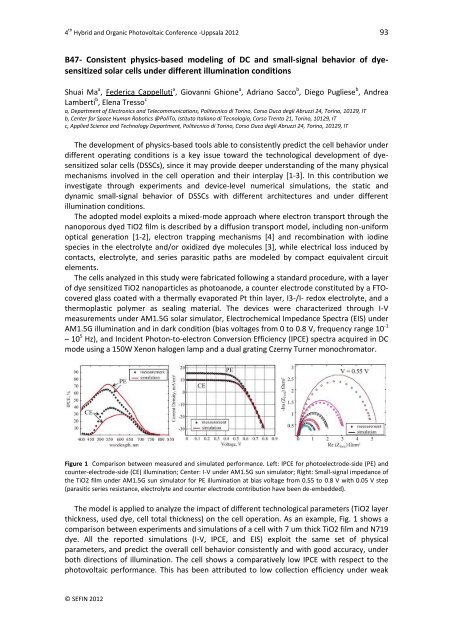HOPV12 - Blogs
HOPV12 - Blogs
HOPV12 - Blogs
Create successful ePaper yourself
Turn your PDF publications into a flip-book with our unique Google optimized e-Paper software.
4 th Hybrid and Organic Photovoltaic Conference -Uppsala 2012 93<br />
B47- Consistent physics-based modeling of DC and small-signal behavior of dyesensitized<br />
solar cells under different illumination conditions<br />
Shuai Ma a , Federica Cappelluti a , Giovanni Ghione a , Adriano Sacco b , Diego Pugliese b , Andrea<br />
Lamberti b , Elena Tresso c<br />
a, Department of Electronics and Telecommunications, Politecnico di Torino, Corso Duca degli Abruzzi 24, Torino, 10129, IT<br />
b, Center for Space Human Robotics @PoliTo, Istituto Italiano di Tecnologia, Corso Trento 21, Torino, 10129, IT<br />
c, Applied Science and Technology Department, Politecnico di Torino, Corso Duca degli Abruzzi 24, Torino, 10129, IT<br />
The development of physics-based tools able to consistently predict the cell behavior under<br />
different operating conditions is a key issue toward the technological development of dyesensitized<br />
solar cells (DSSCs), since it may provide deeper understanding of the many physical<br />
mechanisms involved in the cell operation and their interplay [1-3]. In this contribution we<br />
investigate through experiments and device-level numerical simulations, the static and<br />
dynamic small-signal behavior of DSSCs with different architectures and under different<br />
illumination conditions.<br />
The adopted model exploits a mixed-mode approach where electron transport through the<br />
nanoporous dyed TiO2 film is described by a diffusion transport model, including non-uniform<br />
optical generation [1-2], electron trapping mechanisms [4] and recombination with iodine<br />
species in the electrolyte and/or oxidized dye molecules [3], while electrical loss induced by<br />
contacts, electrolyte, and series parasitic paths are modeled by compact equivalent circuit<br />
elements.<br />
The cells analyzed in this study were fabricated following a standard procedure, with a layer<br />
of dye sensitized TiO2 nanoparticles as photoanode, a counter electrode constituted by a FTOcovered<br />
glass coated with a thermally evaporated Pt thin layer, I3-/I- redox electrolyte, and a<br />
thermoplastic polymer as sealing material. The devices were characterized through I-V<br />
measurements under AM1.5G solar simulator, Electrochemical Impedance Spectra (EIS) under<br />
AM1.5G illumination and in dark condition (bias voltages from 0 to 0.8 V, frequency range 10 -1<br />
– 10 5 Hz), and Incident Photon-to-electron Conversion Efficiency (IPCE) spectra acquired in DC<br />
mode using a 150W Xenon halogen lamp and a dual grating Czerny Turner monochromator.<br />
Figure 1 Comparison between measured and simulated performance. Left: IPCE for photoelectrode-side (PE) and<br />
counter-electrode-side (CE) illumination; Center: I-V under AM1.5G sun simulator; Right: Small-signal impedance of<br />
the TiO2 film under AM1.5G sun simulator for PE illumination at bias voltage from 0.55 to 0.8 V with 0.05 V step<br />
(parasitic series resistance, electrolyte and counter electrode contribution have been de-embedded).<br />
The model is applied to analyze the impact of different technological parameters (TiO2 layer<br />
thickness, used dye, cell total thickness) on the cell operation. As an example, Fig. 1 shows a<br />
comparison between experiments and simulations of a cell with 7 um thick TiO2 film and N719<br />
dye. All the reported simulations (I-V, IPCE, and EIS) exploit the same set of physical<br />
parameters, and predict the overall cell behavior consistently and with good accuracy, under<br />
both directions of illumination. The cell shows a comparatively low IPCE with respect to the<br />
photovoltaic performance. This has been attributed to low collection efficiency under weak<br />
© SEFIN 2012


